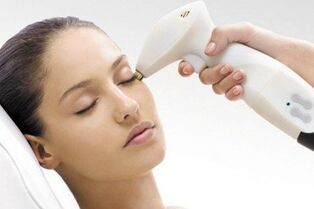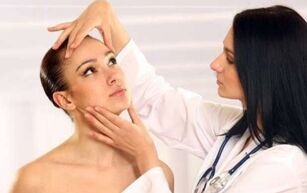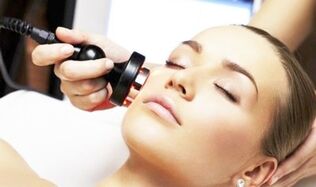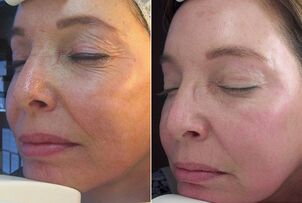For a long time, plastic surgery was the only way to rejuvenate. But this method has many contraindications, and is also associated with some health risks, therefore, not all of them can be solved with the help of surgical intervention. is. Fortunately, modern aesthetic medicine offers many anti-aging treatments that are less dangerous. One of the worthy alternatives to plastic surgery is a laser facelift.
Fortunately, modern aesthetic medicine offers many anti-aging treatments that are less dangerous. One of the worthy alternatives to plastic surgery is a laser facelift.
what is this?
Laser lifting is a modern non-surgical method to combat age-related skin changes. The aim of this technique is to improve skin quality. It stimulates regenerative processes (cell renewal), laser exposure. Improves blood circulation in areas, which helps to lubricate wrinkles.
During theprocess, natural collagen is actively produced, providing tissue elasticity. This is particularly important for areas with delicate skin, where various rejuvenation methods are unacceptable.
The difference between laser lifting and other methods of plastic and facelift is that the procedure does not involve surgery. The operation is performed using special equipment for laser therapy. Light rays penetrate the skinAnd acts on weak and dead cells.
Laser facelifts can be done for women and men between the ages of 18 and 70. Most often, this procedure is required after 30 years, when the first signs of skin aging appear. .
Typically, cosmetologists prescribe laser lifting courses, as one session is not enough. Achieving maximum effect is possible 3 months after the final procedure. With proper skin care, the rejuvenation effect can last for about three years.
prompt for process
Lifting the laser will help solve a large number of problems. The procedure is indicated for patients with the following problems:

- Scorched skin of the eyelids;
- expression and wrinkles of age;
- dark circles and bags under the eyes;
- nasolabial fold pronunciation;
- acne scars;
- small marks;
- enlarged perforation;
- restless color;
- presence of age spots;
- vascular network;
- sagging on double chin;
- neck wrinkles.
Paradox
Laser lifting is contraindicated in the presence of the following factors:
- acute inflammatory and infectious diseases;
- any oncological disease;
- chronic diseases;
- various blood diseases;
- pregnancy and lactation;
- HIV infection;
- diabetes mellitus;
- mental disorder;
- diseases associated with the thyroid gland;
- epilepsy;
- Hepatitis;
- dermatitis of any nature;
- Bad blood clotting.
skin resuscitation types
Currently, in cosmetology practice, laser lifting is done using two techniques: ablative and non-ablative. They differ in that each uses a different type of laser.
ablative
Ablative is the most comprehensive laser lifting technique.The effect of the light beam is directed to the outer layer of the epidermis, which is constantly in contact with the environment.
Under the action of the laser, the layers of dead skin slowly evaporate. The ablative facelift is painful, but it guarantees results.
non-ablative
This technique incorporates a laser beam deep into the skin, stimulating the synthesis of collagen and elastin. The upper layer of the skin remains intact. This method of laser lifting helps to improve tissue tone. , Resulting in a new look.
Unlike ablative tightening, also known as "burn", the non-ablative technique is considered more gentle. The non-elimination method of lifting allows sensitive skin areas - the eyelids and the area around the eyes. Used to influence is allowed.
This technique is not very popular, as many cosmetologists doubt its effectiveness.
Preparation for the process
Prior to the laser lifting procedure, it is mandatory to visit a beautician who will assess the general condition of the skin and draw conclusions about the operation speed.To reduce the risk of side effects, you must pass the following tests:
- General analysis of blood and urine;
- chest X-ray;
- syphilis test;
- HIV test;
- cardiogram of the heart.
The doctor should also know about all the diseases that have occurred to the patient.
About two weeks before the session, the simple rule is to follow:
- Refuse to visit the bathroom, sauna and solarium, and do not soak in the sun;
- Do not consume alcoholic beverages;
- drink antiviral drugs in a course (prescribed only by a cosmetologist).
It is not advisable to consume coffee and energy drinks on session day.
how is the facelift done?
Laser lifting technique is relatively simple:
- The patient puts a medical cap or bandage over his head to remove his hair and couch. But lies down
- Next, the doctor prepares the skin: removes remnants of makeup and greasy secretions.
- Then a cold gel is applied on the face. For patients with very sensitive skin, anesthetic creams are used.
- The procedure is painful. For this reason, it is often performed under local or general anesthesia.
- During the session, the patient's eyes have to be protected, so they wear dark glasses. After completing the initial measures, you can start the laser lifting process.
- The doctor moves a special device with a flatter (pupil) on the patient's face, paying attention to the problem areas in particular and working them carefully.
Different devices are used depending on the process used. This differs in the technique of exposure and the depth of penetration of the light beam.
There are two types of lasers: cold and hot. For a facelift, a carbon dioxide, erbium, or diode laser can be used.
- Carbon dioxide laser is the most powerful. Helps to get rid of any wrinkles and scars.
- Erbium effectively fights the first signs of aging. There is a mild effect on the surface of the skin.
- Deep skin rejuvenation is done through a diode laser. The light beam can penetrate 5-50 mm inward.
Ablative rejuvenation is done with a carbon dioxide laser. Under the effect of heat, dead cells slowly evaporate, and eventually new and young skin survives.
erbium and diode lasers are used for non-ablative facelifts.The action of light rays is directed to the inner layers of the skin. Collagen production processes are triggered in the connective tissues, contributing to tightening and rejuvenating the skin.
After the end of the procedure, the beautician treats the patient's face with an antiseptic, then applies a soothing cream or mask.
before and after photos
On further picture you can see the result before and after the process.

rehabilitation
The duration of the rehabilitation period depends on the technique of the procedure.The more intense the effect, the longer the complete restoration of the skin will take.
During rehabilitation, skin redness, swelling, and hypersensitivity are common. These are permissible results of laser lifting and should not alarm. After a few days, the symptoms will disappear on their own.
After a laser lift, the skin needs gentle care. The patient should strictly follow the doctor's recommendations and follow the following rules:
- Do not go to the pool, sauna, bathrooms and beach for two to three months;
- Be sure to use sunscreen while going out;
- Do not use decorative cosmetics until the skin is fully restored;
- Try to touch your face with your hands as much as possible;
- exclude facial massage;
- Quit bad habits;
- Follow a healthy diet;
- Drink lots of fluids.
With proper care and adherence to the beautician's instructions, the results of tightening can already be seen after seven days. The skin will become stronger and healthier, wrinkles and scars will disappear. Face oval. Will take a similar shape and clearer outline. Changes are usually not visible immediately after the procedure.
Complications
Laser facelift is considered a safe method of rejuvenation. During the procedure, there is no direct skin contact with the equipment, so the risk of infection of various diseases is minimal. Complications can occur in two cases. Are: Inadequate level of professionalism of cosmetologists and noncompliance by patient with care regimens.
The following side effects are the most dangerous:
- ringworm;
- increased pigmentation of the skin;
- whiteheads;
- scar formation (in case of tearing of formed crusts).
























































